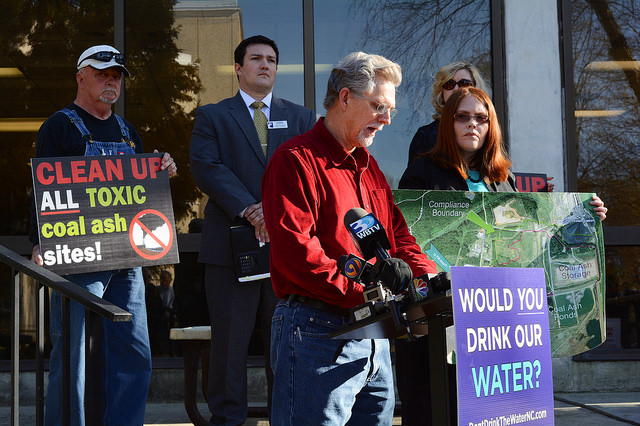Cleaning Up Coal Ash
For well over a century, power plants across the country have burned coal to generate electricity. And for just as long, leftover coal ash has been dumped in open, unlined pits near the power plant, usually located on a river or lake. Every year, U.S. power plants produce 130 million tons of coal ash, which is the second largest waste stream in the country after municipal garbage.
Coal ash concentrates the toxic heavy metals found in coal, including arsenic, mercury, lead and selenium. Stored in unlined, wet impoundments, coal ash has been leaking these toxics into our groundwater and surface waters for years. Sometimes these impoundments collapse — with disastrous results.
Yet government regulations for coal ash management are either non-existent or sparse, and there is little enforcement of the regulations that do exist. In North Carolina, this lack of oversight — and the complicity between state regulators, elected officials and Duke Energy — came to a boiling point in February 2014 when one of Duke’s coal ash impoundments spilled 39 million tons of ash into the Dan River.
Citizens living near North Carolina’s 33 coal ash impoundments — all of which have leaked — have fought for transparency from Duke and the state, and for cleanup of the pollution that threatens their property value, health and family. Their actions forced this issue into the headlines of news networks and to the forefront of environmental justice conversations in the United States.
Appalachian Voices stood with these communities as we worked for years to compel Duke Energy and the N.C. Department of Environmental Quality to excavate coal ash from all the North Carolina sites and dispose of it either in lined, dry landfills, away from waterways, or by recycling it for concrete or other uses, provided it’s done in a manner that protects public health and the environment.
On Jan. 2, 2020, North Carolina announced a historic settlement with one of the state’s most powerful corporations and polluters, Duke Energy. The settlement requires Duke to move nearly 80 million tons of toxic coal ash at six of its power plants to properly lined landfills onsite or recycle it.

Learn information about specific coal ash impoundments in the South, including health threats and safety ratings:
Additional Resources
Fact sheets, videos, links to academic research, and more
Sign Up to Act
Help us protect the health of our communities and waterways.
Latest News
DuPont to Pay $50 Million in Pollution Settlement
In a settlement reached in December 2016, DuPont Chemical will pay over $50 million for releasing mercury into Shenandoah Valley waterways.
Fighting for clean water after the Stream Protection Rule
When Congress voted last week to overturn the Stream Protection Rule, people braced themselves for the coming impacts. But threats to public water from corporate and political interests are nothing new in Central Appalachia, nor is the problem unique to this area. In the face of these threats, communities fighting for clean water need our continued support.
Serving residents by saving energy
Students at Appalachian State University in Boone, N.C. spent a recent Saturday volunteering with Appalachian Voices and others to give two local homes an energy efficiency boost. The work was part of the school’s 18th annual MLK Challenge. “They caught energy leaks I knew nothing about,” said Faith Wright of Vilas, N.C., who was grateful for the volunteer energy of what she called the “student worker bees.”
Defending our vision for Appalachia
In our view, the new administration’s approach to environmental protection and national energy policy is dangerously shortsighted. We will do everything we can to see that the laws protecting our natural heritage and the communities of Appalachia are enforced, and not be distracted from our vision for a healthy, sustainable future for our region and beyond. We know you’ll stand with us during this uncertain time.
Duke Energy neighbors say “goodwill” package is meant to buy silence
From the Alliance of Carolinians Together Against Coal Ash: On Friday the 13th, Duke Energy released a “goodwill” offer to residents on wells near the company’s coal ash sites. To many residents, however, the ominously timed release is more hush money than it is an act of goodwill.
Standing up for the Stream Protection Rule
Countless citizens have worked for years to push for a federal rule that would help safeguard drinking water sources and surface waters in coal-impacted communities. It finally goes into effect today, but Congress and the incoming administration have vowed to kill it. Appalachian Voices, in alliance with others, is standing up to defend the Stream Protection Rule.









